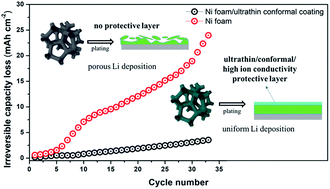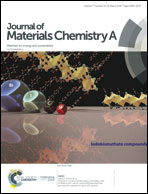Depressing the irreversible reactions on a three-dimensional interface towards a high-areal capacity lithium metal anode†
Abstract
Construction of 3D electrode structures has emerged as an effective way to stabilize Li metal anodes. However, a 3D porous structure with relatively large surface area will enlarge the contact area between the electrolyte and Li, resulting in a low coulombic efficiency and capacity decay due to electrolyte decomposition at the 3D interface, especially under high areal capacity conditions. Herein, an ultrathin and conformal lithium-ion conductive coating, composed of a PEO/LiTFSI-based solid polymer electrolyte with graphene oxide as a functional filler to enhance the ionic conductivity, is proposed as a protective layer to address the abovementioned issues for 3D Li metal anodes. This coating layer can be applied to various 3D current collectors, such as Ni foam and carbon fiber cloth, and is effective in suppressing electrolyte decomposition and guiding uniform deposition of Li beneath it. As a result, the irreversible capacity loss of the protected 3D Li anode reduces to one-sixth that of the uncoated anode, and an average coulombic efficiency of 98.9% and stable cycling for over 800 h can be achieved at the high areal capacity of 10 mA h cm−2. This study establishes a general approach of surface modification to depress the irreversible reactions on the surface of practical 3D metallic Li anodes.



 Please wait while we load your content...
Please wait while we load your content...